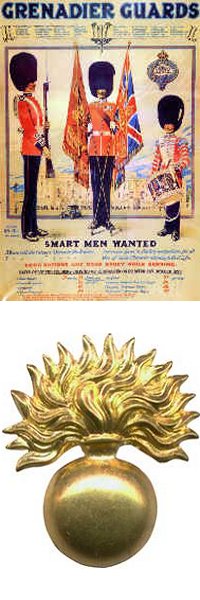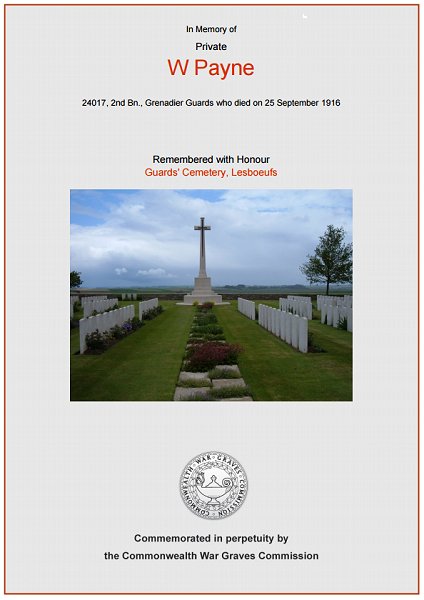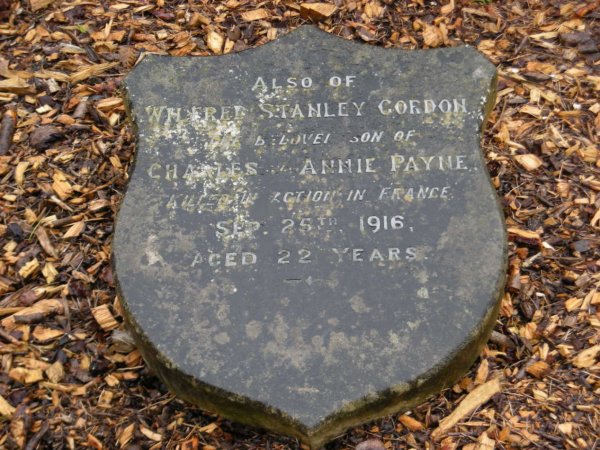yeovil at War
Wilfred Stanley Gordon Payne
Killed in the action at Lesboeufs, Somme, aged just 22
Wilfred Stanley Gordon Payne was born in Yeovil in 1894, the son of postman Charles Payne (1861-1927) and Annie Elizabeth née Norman (1865-1937), both originally from Preston Plucknett. Charles and Annie were to have four children (although one child had died in infancy); Wilfred, Elsie Maud (1896-1986) and George henry (b1901).
In the 1901 census Charles and Annie were living in Huish with Wilfred, Elsie and George, together with Annie's mother, Hannah Norman, and Annie's brother William who was a visiting soldier. They also had a lodger.
In the 1911 census the family were living at 173 Huish; Charles and Annie, the three children and Charles' mother Susan Rodber. 17-year old Wilfred gave his occupation as a grocer's assistant and is known to have worked for the Yeovil & District Co-operative Society. Wilfred was a well-known athlete, and played for Yeovil Thursday’s Football Club.
 Wilfred
enlisted at
Yeovil as a
Guardsman in 2nd
Battalion,
Grenadier
Guards, 4th
(Guards)
Brigade, 2nd
Division.
Although the
Western Gazette
later claimed
Wilfred enlisted
"soon after the
out break of
hostilities" his
Service Number
24017 confirms
that he actually
enlisted in
August 1915.
Wilfred
enlisted at
Yeovil as a
Guardsman in 2nd
Battalion,
Grenadier
Guards, 4th
(Guards)
Brigade, 2nd
Division.
Although the
Western Gazette
later claimed
Wilfred enlisted
"soon after the
out break of
hostilities" his
Service Number
24017 confirms
that he actually
enlisted in
August 1915.
When war broke out the 2nd Division sailed for France almost straight away as part of the British Expeditionary Force (BEF), landing at Le Havre on 15 August 1914. Indeed the 2nd Division was one of the first British formations to move to France, where it remained on the Western Front throughout the war. In August 1915 the 2nd Battalion transferred to the 1st Guards Brigade of the Guards Division.
It is likely that Wilfred did not join his battalion at the front until the end of 1915 or early 1916.
Other than the grueling day-to-day fighting of the Western Front, the first major battle that Wilfred and the 2nd Battalion were involved in during 1916 was the Battle of Flers-Courcelette.
The Battle of Flers–Courcelette was a battle within the Somme Offensive, launched on 15 September 1916 with the battle continuing for a week. Flers–Courcelette began with the objective of cutting a hole in the German line by using massed artillery and infantry attacks. This hole would then be exploited with the use of cavalry. It was the third and final general offensive mounted by the British Army during the Battle of the Somme. By its conclusion on 22 September, the strategic objective of a breakthrough had not been achieved; however tactical gains were made in the capture of the villages of Courcelette, Martinpuich and Flers. In some places, the front lines were advanced by over 2,500 yards (2,300 m) by the Allied attacks. The battle is significant for the first use of the tank in warfare. It also marked the debut of the Canadian and New Zealand Divisions on the Somme battlefield.
Lesboeufs is a village 16 kilometres northeast of Albert. Lesboeufs village was attacked by the Guards Division on 15 September 1916 and captured by them on the 25th - the day Wilfred Payne was killed in this action. He was aged just 22.
In its edition of 27 October 1916 the Western Gazette reported "Much regret has been expressed with Mrs Payne, of 175 Huish, in the death in action of her eldest son, Private W Payne, of the Grenadier Guards. Private Payne, who joined the Grenadier Guards soon after the out break of hostilities, was, prior to enlistment, employed as a shop assistant at the Co-operative Stores. He was a well-known athlete, having played for Yeovil Thursday’s Football Club. Private Payne’s father, who holds the rank of Sergeant, and who is an old soldier, is now doing duty as a drill-instructor at Taunton Barracks."
William Payne is commemorated on Memorial 73, Guards' Cemetery, Lesboeufs, Somme, France, and his name is inscribed on the War Memorial in the Borough.
gallery

The Commonwealth War Graves Commission certificate in memory of Wilfred Payne.

The plaque in memory of Wilfred Payne, by the grave of his parents in Yeovil cemetery.